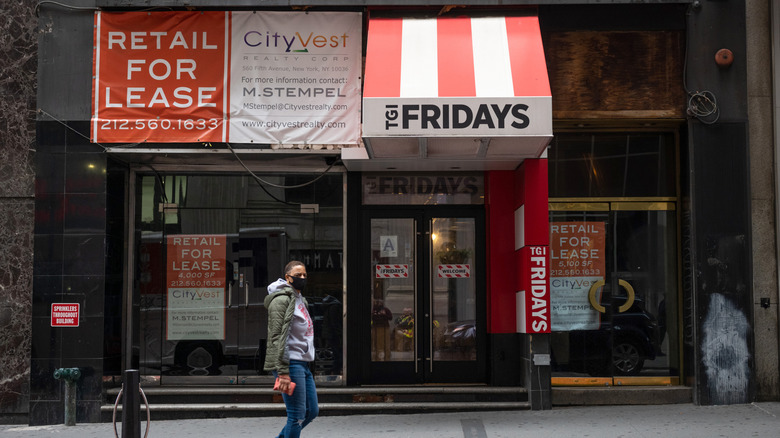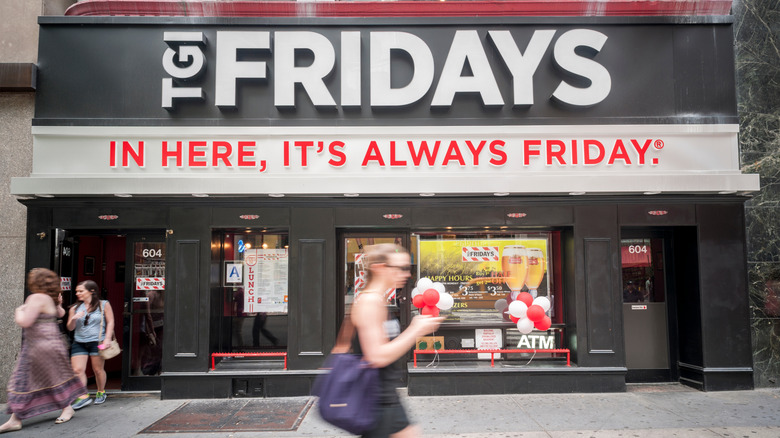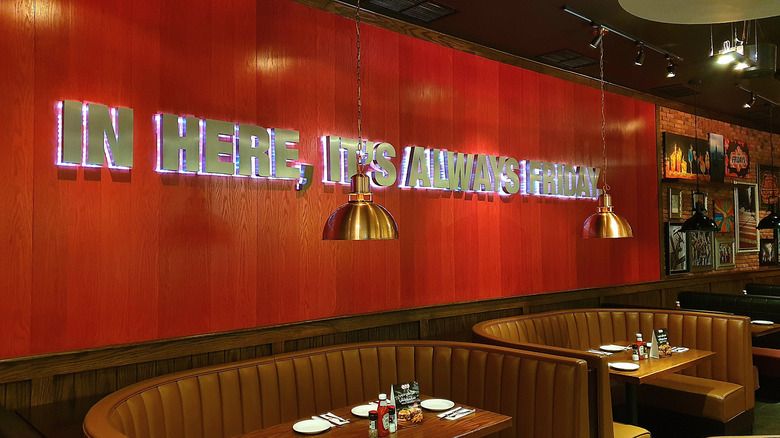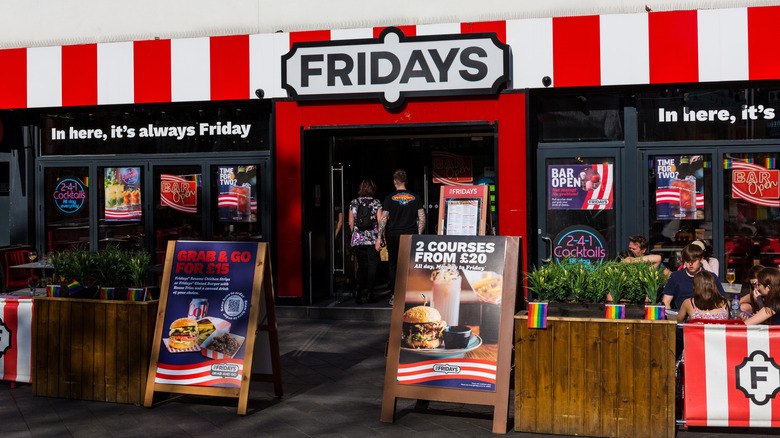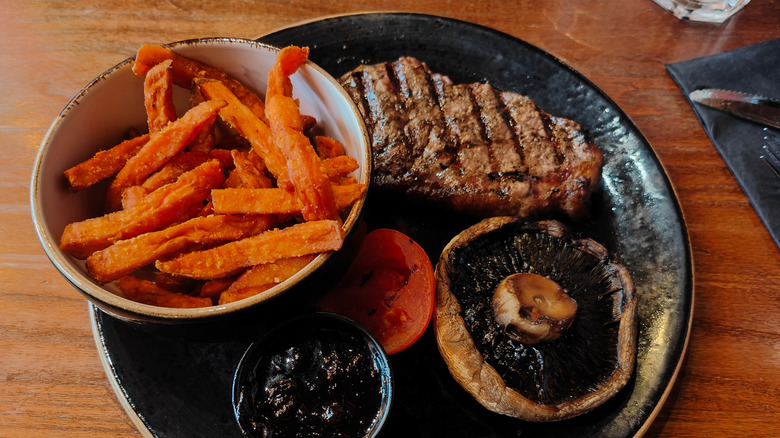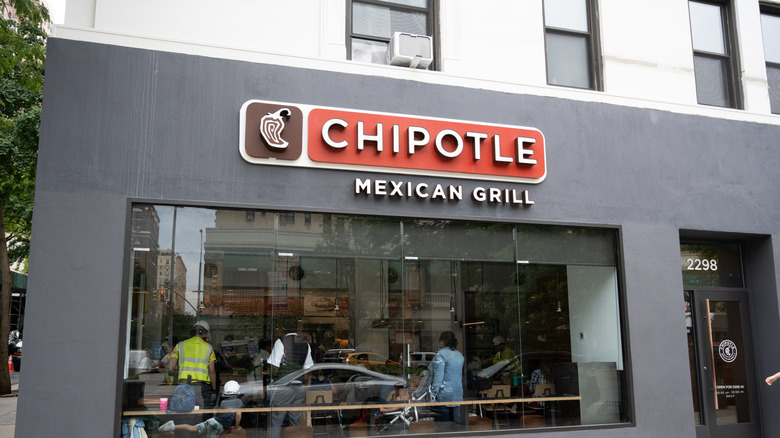The Only Recap Of TGI Fridays' Downfall You Need
TGI Fridays was once the heartbeat of casual dining in America, from its vibrant beginnings as one of the original restaurants to put happy hour on the map. Even still, the famous apps and classic cocktails could not shield the chain from a relentless decline that was fueled by a mixture of pandemic pressure, financial overreach, and shifting consumer tastes. The chain has lost 55% of its locations in the U.S. since 2008, while its sales have also gone down by more than 60%.
The big blow came in November 2024, when TGI Fridays filed for Chapter 11 bankruptcy, citing structural debt issues and COVID-19 impacts as primary contributors. In the months that followed, the chain closed nearly 130 U.S. restaurants, and also had four closures in early 2025 across its casino locations in Las Vegas. With a lot of closures to date, TGI Fridays now stands at the crossroads of reinvention or further erosion.
Pandemic shock and changing consumer behavior worsened TGI Fridays' financial position
TGI Fridays was already not doing well before the COVID-19 pandemic, and the lockdowns and social distancing mandates just made matters worse for the chain. It was already struggling to figure out how to handle rising costs, heavy debt burdens, and shifting customer habits. As many dine-in restaurants tried to deal with the effects of the pandemic, TGI Fridays found itself particularly exposed.
At the same time, its consumers — who were haunted by inflation and health concerns — pivoted sharply away from sit-down dining toward more affordable and convenient alternatives. In short, the pandemic did more than just disrupt — it amplified existing vulnerabilities, and quickened TGI Fridays' downward trajectory toward filing for bankruptcy. In a statement regarding its Chapter 11 filing in November 2024, the company cited the effects of the COVID-19 pandemic as the "primary driver" of its "financial challenges."
Crippling private equity debt structure didn't help matters
Before the pandemic came along, the foundations for the chain's downfall had been set by something completely different. TGI Fridays was already struggling. Quite a bit of its troubles can be traced to its private equity ownership and the burdensome debt structure that came along with it. After Sentinel Capital Partners and TriArtisan Capital Advisors acquired it in 2014, the brand was saddled with significant leverage, which limited its ability to reinvest in operations, modernize its menus, or refresh some of its outdated restaurants. What this did was turn TGI Fridays into a textbook example of how aggressive buyouts can strain a company's long-term viability. Its revenues were often directed toward servicing its debts instead of innovation or enhancing customer experience.
By the time the pandemic came along, TGI Fridays had little financial flexibility left. Interest payments and financial engineering left the company unable to keep pace with evolving customer trends. The heavy debt structure made it difficult for the chain to adapt when it wanted to as it had to take care of debts first. What could have been a temporary setback for a leaner competitor became an existential crisis for TGI Fridays, as the weight of its private equity ownership left little room to maneuver when revenues collapsed.
Corporate missteps and securitization fallout
TGI Fridays' financial unraveling was made deeper when the chain lost control of its key business assets that were tied to a 2017 whole business securitization which is a debt structure that is backed by its franchise agreements, royalty revenue, licensing rights, and intellectual property. In September 2024, the trustee of this deal terminated TGI Fridays as the securitization manager following its failure to submit documents that were needed for an audit on time. This marked the very first manager termination event of its kind since, literally, the Great Recession in 2007, and as a result, a company called FTI Consulting was appointed as an interim successor manager. The company became responsible for vital functions such as franchise support, royalty collection, and marketing oversight — functions that are essential to brand continuity.
The fallout was swift. A pending acquisition by Hostmore, which was the U.K. franchisee, did not go through because this securitization crisis surfaced. Its bondholders' takeover of management rights messed up the deal, signaling to potential buyers and investors that TGI Fridays was no longer in control of its own operations. To top it off, a weakened financial profile and lack of managerial control alarmed its creditors. Court filings showed that the fact that TGI Fridays did not have control over its own assets undermined both its liquidity and strategic flexibility moving forward.
Leadership turmoil and constant C-suite shake-ups caused instability
As TGI Fridays neared bankruptcy, leadership instability was another thing that complicated its ability to chart a steady course during its years of decline. In the years that were leading up to its bankruptcy filing, the company cycled through a lot of CEOs and senior executives, each bringing in new strategies that barely lasted. According to Nation's Restaurant News, these frequent leadership changes created inconsistency in the chain's direction, leaving franchisees and staff without a clear long-term vision. And it wasn't just the C-suite that had problems.
Business Insider reported that the management teams were struggling to balance the demands of its private equity owners with the operational realities of running a chain that was going through hard times. Whenever new leaders arrived, plans that were intended to modernize the brand — like menu overhauls — would be put on pause or reversed as new leaders arrived, creating a cycle of half-implemented strategies. This lack of stable leadership not only reportedly demotivated franchise operators but also made it difficult for the chain to respond effectively to external pressures such as inflation, labor shortages, and the pandemic. Meanwhile, its more stable competitors were able to invest consistently in technology, delivery platforms, and streamlined menus. For TGI Fridays, however, the revolving door of leadership just created uncertainty at precisely the moment when the chain needed steady hands the most.
Failed deals and fragmented ownership put even more strain on the chain
Another reason for TGI Fridays' decline was the collapse of key deals and a splintered ownership structure — especially evident in the United Kingdom's turbulent experience. In September 2024, the U.K. arm entered administration, which placed its 87 locations and about 3,000 jobs at a risk. However, a rescue plan was attempted in October 2024 when private investors Breal Capital and Calveton acquired approximately 51 stores. While this intervention saved around 2,389 jobs, it didn't stop the abrupt closure of 35 others and the loss of 1,012 positions. Even among locations that were trying to survive, fragmentation persisted.
The cherished Leicester Square flagship in London was permanently closed in January 2025, despite its initial expectations to remain open under new ownership. On the other hand, even before the pandemic, TGI Fridays had been interested in a public listing through a merger with Allegro Merger Corp., totaling around $380 million. However, the deal fell apart in early 2020 amid extraordinary market conditions triggered by the onset of COVID-19, which showed early missed opportunities to stabilize through capital markets. These events underscore how fragmented ownership, coupled with failed rescue and public deal efforts, crippled both the chain's investor and consumer confidence.
Massive U.S. restaurant closures and shrinking footprint
In early 2025, TGI Fridays undertook one of the most dramatic contractions in casual-dining history. Since it filed for Chapter 11 bankruptcy in November 2024, the chain closed about 130 locations in the U.S. – which is a staggering reflection of its prolonged sales slump and operational fragility. Among some of its abrupt decisions was the closure of nearly 50 establishments in October 2024, all done within a single week. Though, the chain's footprint was declining long before that. Things deteriorated between 2008 and 2023, when TGI Fridays had closed about 55% of its U.S. locations, while its domestic sales took a dramatic 60% hit.
As of March 2025, about 39 stores remained part of the official bankruptcy estate; and of these, nine were waiting to be sold to restaurant operator Mera Corp. for $34.5 million. However, the brand still has an international presence — with nearly 400 locations worldwide, many are operating under franchise agreements. The company maintained leadership stability through executive chair Rohit Manocha who took charge of worldwide franchise operations during this time of crisis. The extensive closures marked the final stage of the American presence of a formerly successful chain.
Gift card liability put potential financial burden on franchisees
Another consequence of TGI Fridays' Chapter 11 bankruptcy that's concerning is the financial burden threatening its franchisees — specifically around the $50 million in outstanding gift card obligations. When the chain filed for bankruptcy on November 2, 2024, it managed to secure only $5.9 million in cash to begin its restructuring efforts. While this was happening, franchisees warned in court that they could be left personally responsible for honoring customer gift cards — even though there was no assurance of reimbursement from TGI Fridays' corporate side. This issue simply comes from standard practice where franchises often redeem gift cards at point-of-sale and then bill the parent company.
But with the TGI Fridays issues, franchisees voiced concern that recompense might never come. Still, a United States bankruptcy judge granted the chain an interim approval to continue its gift card program. Industry analysts note that gift cards are widely considered unsecured liabilities in bankruptcy cases; if many customers rush to redeem them, it could severely strain already tight-margin operations at franchise locations.
Too little, too late with failed modernization, including menu missteps
TGI Fridays tried to modernize its menu and most often missed the mark — either through confusing loyal customers or failing to attract new ones. Insights from analysts online cite misaligned innovations, like bringing in sushi or poke bowls, that neither resonated with its core customers nor drew fresh traffic, which diluted the brand's identity instead of enhancing it. These insights show that TGI Fridays failed to stand out in its crowded casual dining market while its pursuit of trendy items led to its downfall. The Grilled & Sauced menu launch at the beginning of 2023 – its biggest menu shake-up since the '90s – introduced customizable protein options, including Tomahawk pork chops with strong sauces. The point here was to try and spot meat quality — offering steakhouse-style dry rubs or al pastor-inspired options — but this culinary shift did little to overcome structural problems in the business. After filing for bankruptcy, a drastic revamp followed.
In May 2025, TGI Fridays overhauled approximately 85% of its menu, cutting underperforming items, upgrading ingredients, and returning to hands-on preparation like hand-breaded chicken and hand-cut steaks. This new look also came with revamped mozzarella sticks, a new TGI Sauce, and cocktails that looked really pretty — aimed at engaging younger diners. Regardless, the problem the chain had was timing and coherence. With only about 85 U.S. locations left at that point, the chain had spent too much time focusing on the menu instead of reimagining its core value proposition.
Neglecting digital and delivery growth was a missed opportunity
TGI Fridays' decline was not just about it having misjudged menu revamps or closing locations, it also reflected how it struggled to keep up with how its customers like to eat. Even though the chain had previously leaned into digital and delivery – through testing alcohol and food drop-offs in select cities and launching third-party delivery integrations – these initiatives were inconsistent and underprioritized at a critical time. But instead of creating a stable omnichannel strategy, TGI Fridays' efforts remained fragmented, leaving competitors to capture customers that were digitally savvy more effectively.
Even though the brand also tried to experiment with virtual kitchens and additional digital storefronts – like the partnerships with C3 to pilot ghost brands and online marketplaces — it was a little too late for it to meaningfully stem the tide of declining foot traffic and sales. Even though it tried to expand its digital presence in unexpected ways, the chain's hesitation, through only being proactive and not reactive, to fully embrace and scale contactless services, mobile ordering, and delivery platforms reduced TGI Fridays' visibility and convenience. It turned out to be a critical misstep as today's world is leaning more on digital efficiency. This gap underscores how not modernizing the core delivery channels left this brand out of step with ever-evolving consumer expectations.
Operational weaknesses result in poor customer experience
TGI Fridays' operational issues became a significant drag on its recovery efforts. One of the main problems was inconsistent food quality, with customer reports that were frequently mentioning dishes that arrived poorly cooked or below expectations across locations. The restaurant experienced extended delays for both seating and food service during busy times which indicated poor coordination between staff members and inadequate front-of-house operational systems.
Negative reviews online pointed to surface-level upkeep issues affecting overall perception — which was an especially damaging flaw for a brand known for its fun and lively atmosphere. To top it all off, TGI Fridays' marketing and menu strategies revealed additional operational misfires. There was limited advertising that persisted even as competitors ramped up their outreach. The chain failed to attract health-oriented customers because it did not provide enough light and nutritious food choices that matched changing consumer tastes. Even though the chain had a popular chicken dish, the combination of inconsistent food quality and slow service and unclean environment and outdated value proposition at TGI Fridays created an outdated dining experience because customers now prefer modern casual dining options that deliver quick service and healthy choices.
Increased competition from fast casual chains was too much for TGI Fridays
TGI Fridays' decline cannot be fully understood without also taking a look at the competition from fast-casual and quick-service concepts — formats that seemed to erode its traditional casual-dining foothold. Fast-casual restaurants have managed to win over today's generation of customers through quick service and budget-friendly prices and dependable quality. In this regard, the expansion of fast-casual restaurants created challenges for TGI Fridays to maintain its market position.
Industry analysts emphasize that casual-dining chains are now facing an upheaval due to soaring labor and real estate costs, declining foot traffic, and options that offer more convenience at lower prices. Fast casual food chains benefit from leaner operations and appeal to modern consumers, usually looking for speed, affordability, and quality. Fast casual restaurants like Chipotle, Panera, and Sweetgreen succeeded in securing customers who wanted convenient meals with personalized options and premium ingredients — which many casual dining restaurants, like TGI Fridays, failed to implement with menu options.

